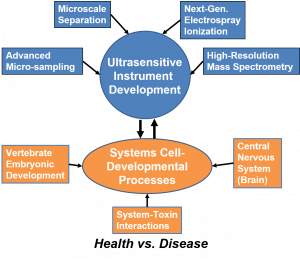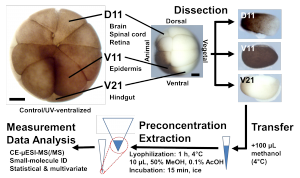OUR GOALS

The Nemes Research Group (NRG) develops next-generation mass spectrometry technologies to enable the ultrasensitive characterization of molecular processes with critical roles during development. We combine these technologies with powerful models from biology and health studies to study how broad types of molecules contribute to development in space and time. Our interdisciplinary research advances bioanalytical chemistry and basic biology and raises important implications for human health.
To achieve these goals, our objectives transcend across classical disciplines:
Objective 1. Develop ultrasensitive mass spectrometry technologies for proteins and metabolites. To understand biomolecular processes coordinating development, we first develop new mass spectrometry instruments to enable the discovery characterization of proteins-to-metabolites. These instruments enable sufficient sensitivity to identify and quantify molecules in limited amounts of tissues, ranging from small biopsies to single embryonic cells and neurons. Our analytical approach combines microscale sampling, high-capacity separation by capillary electrophoresis (CE) and by ultraperformance liquid chromatography (UPLC), high-efficiency electrospray ionization (ESI), and high-resolution tandem and multistage mass spectrometry (HRMS). To accomplish this objective, we have a number of projects in progress, ranging from instrument and methodology development to applying these instruments for biological research.
Objective 2. Understand cell-developmental processes underlying normal and impaired development. We employ our custom-built ultrasensitive mass spectrometry instruments to study molecular mechanisms during development. We use the South African clawed frog (Xenopus laevis) to determine how the single-cell zygote differentiates into multiple cells that then give rise to the various tissues of the embryo. In parallel, we also use the mouse to study how differential translation of the genome establishes neuron heterogeneity for normal development of the mammalian nervous system. Additionally, we use mammalian cell cultures to study how the system responds to external stimuli, such as drugs of treatment and toxins. To accomplish this objective, we have several projects in place, ranging from patterning of the body axis and tissue specification to functional validation of molecules.
OUTCOMES FROM OUR RESEARCH
A complete list of publications and presentations is available. Representative outcomes are summarized as follows:

New bioanalytical platforms and methodologies:
- We have custom-built metabolomic CE-ESI-HRMS platform
- We have custom-built proteomic CE-ESI-HRMS platform
- We have developed high-throughput LC-ESI-HRMS approaches
New knowledge for cell/developmental biology:
- We have uncovered metabolic differences between single embryonic cells in the early developing Xenopus laevis embryo.
- We have found proteomic differences between single embryonic cells in the early developing Xenopus laevis embryo.
- We have discovered small molecules that are able to alter the normal tissue fate of embryonic cells in the Xenopus laevis embryo.
New tools for neuroscience:
- We have characterized hundreds of proteins in total protein amounts estimated to be contained by a handful of neurons in the mouse.
Fast assessment of mechanisms of action:
- We have developed rapid, high-throughput methodologies in proteomics to determine the mechanism of action for drugs of treatment.